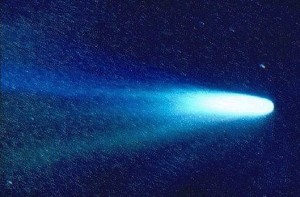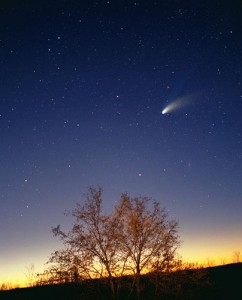Halley
 In 1705 Edmond Halley predicted, using Newton’s laws of motion, that the comet seen in 1531, 1607 and 1682 again in 1758. The comet returned as predicted, and later it was named in his honor.
In 1705 Edmond Halley predicted, using Newton’s laws of motion, that the comet seen in 1531, 1607 and 1682 again in 1758. The comet returned as predicted, and later it was named in his honor.
The average period of Halley’s orbit is 76 years, but you can not calculate the dates of their recurrence accurately. The gravitational pull of the major planets alters the period of the comet in each orbit. Other effects, such as the reaction of the gas ejected during the passage near the Sun, also play an important role in altering the orbit.
Halley’s orbit is retrograde and inclined 18 ° from the ecliptic. And, like all comets, highly eccentric. The nucleus of Comet Halley is approximately 16x8x8 kilometers.
Contrary to previous assumptions, the nucleus of Halley is very dark, black as coal and one of the darkest objects in the solar system.
The density of the nucleus of Halley is very low: about 0.1 grams/cm3, indicating that it is probably porous, perhaps because of the large amount of dust that remains after the ice has been sublimated.
The Halley is almost unique among comets, since it is both large and active, and has a regular orbit, well defined, but may not be representative of comets in general.
Halley’s Comet returns to the inner solar system by the year 2061.
Hale-Bopp
 The Hale-Bopp is a periodic comet that returns every 3000 years and came to Earth in 1997, causing great expectation. Alan Hale in New Mexico and, independently, Thomas Bopp of Arizona, discovered the comet that now bears the name of both. Soon after the discovery became clear that the comet could be brighter in recent years.
The Hale-Bopp is a periodic comet that returns every 3000 years and came to Earth in 1997, causing great expectation. Alan Hale in New Mexico and, independently, Thomas Bopp of Arizona, discovered the comet that now bears the name of both. Soon after the discovery became clear that the comet could be brighter in recent years.
Comet Hale-Bopp was at that time one of the brightest stars in the sky, reaching magnitude -0.8 unna, which means that the comet was brighter than any object in the night sky at that time, with the exception of Luna, Sirius and Mars.
Despite its brightness, the comet Hale-Bopp not came close to Earth. At closest approach was 194 million miles away, that is a little farther from us than the Sun
It is believed that the comet’s nucleus is relatively large, about 40 miles according to the estimates, since it is not possible to see directly the core. However, more than the core, the determining factor in brightness of the comet’s coma, the envelope of gas and dust surrounding the comet’s nucleus.
Approaching the sun part of the comet sublimates. Some comets develop multiple queues, and in particular in Hale-Bopp was possible to see two queues, one for gas and a powder. The tail of the comet Hale-Bopp, difficult to observe from the cities, reached several million miles long.
 Follow
Follow